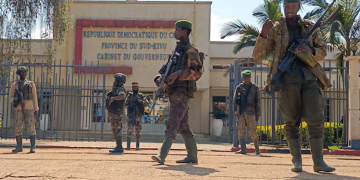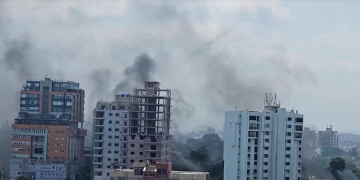In a provocative statement during his annual end-of-year press conference, Russian President Vladimir Putin challenged the United States and its Western allies to a “high-technology duel” to test the capabilities of Russia’s latest hypersonic ballistic missile, the Oreshnik.
This missile, named after the Russian word for hazel tree, is designed to penetrate advanced missile defence systems and has become a focal point in the ongoing tensions between Russia and the West.
The Oreshnik Missile: A Technological Marvel
The Oreshnik missile is an advanced intercontinental ballistic missile (ICBM) capable of carrying both conventional and nuclear warheads.
With reported speeds of up to 8,500 miles per hour, it represents a significant enhancement to Russia’s military arsenal.
During the press conference, Putin emphasized that this new weapon could outmaneuver existing air defense technologies, asserting that “Western technology stands no chance” against it.
Putin’s challenge invites the U.S. to select a target in Kyiv for Russia to strike with the Oreshnik, effectively demonstrating its ability to bypass sophisticated defense systems.
“We’re ready for such an experiment,” he declared, showcasing confidence in the missile’s capabilities.
Recent Deployments and Strategic Implications
The Oreshnik made its combat debut in November when it was deployed against a military facility in Dnipro, Ukraine.
This action was framed as retaliation for Ukraine’s use of Western-supplied missiles, including American ATACMS and British Storm Shadow missiles, in strikes against Russian territory.
As tensions escalate, Putin’s challenge raises critical questions about the effectiveness of Western air defense systems.
If the Oreshnik can indeed evade interception, it could shift the balance of power in ongoing military engagements.
Ukraine’s Response: Questioning Rationality
Ukrainian President Volodymyr Zelensky responded to Putin’s challenge with scepticism, questioning the logic behind such a proposal. “Do you think he is a sane person?”
Zelensky asked reporters during a recent news conference. He highlighted that previous discussions between Russian and Ukrainian negotiators in Istanbul had failed to yield any agreements, further complicating the diplomatic landscape.
Zelensky’s remarks reflect broader concerns about Putin’s intentions and mental state amid escalating hostilities.
The Ukrainian president reiterated that no binding agreements had been reached during earlier negotiations, emphasizing Ukraine’s refusal to comply with Russian ultimatums.
The Broader Context: A New Arms Race?
Putin’s challenge not only underscores Russia’s confidence in its new military technology but also signals an intent to provoke a response from Western powers.
This situation raises important questions about how NATO and allied nations will react to such provocations and whether they will enhance their own defensive capabilities in response.
The emergence of advanced weapons like the Oreshnik highlights an ongoing arms race that could redefine military strategies on both sides.
As countries invest in developing countermeasures against hypersonic threats, the stakes continue to rise.
A Dangerous Game
As Vladimir Putin challenges the West to test the capabilities of Russia’s Oreshnik missile, the implications for global security are profound.
The potential for miscalculation or escalation remains high as both sides navigate this complex geopolitical landscape.
With President Zelensky questioning Putin’s rationality and intentions, it is clear that this high-stakes game will require careful diplomacy and strategic foresight from all involved parties.
The world watches closely as these developments unfold, hoping for de-escalation rather than further conflict.
Credit: Tuko













